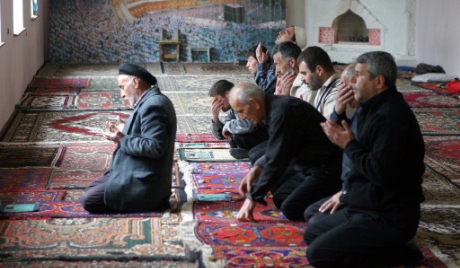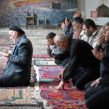
National Anti-Terrorism Committee Admits Ideological Roots of Terrorist Threat
Publication: Eurasia Daily Monitor Volume: 10 Issue: 132
By:

The Russian media have reported that in June alone, more than 20 people were killed and wounded in the North Caucasus (www.kavkaz-uzel.ru/articles/226418/). Against the backdrop of such news, government official made a sensational statement about Russia’s ability to cope with the terrorist threat in the run-up to next year’s Winter Olympics in Sochi. Speaking at a conference in Pyatigorsk on June 24, an official with the National Anti-Terrorist Committee (NAC), Nikolai Sintsov, stated that despite the efforts made by the law enforcement agencies, the level of the terrorist threat in the North Caucasus remains fairly high (https://stavropol.rusplt.ru/index/nak-podtverdil-vyisokuyu-terroristicheskuyu-ugrozu.html).
In fact, the NAC representative was simply admitting what had been obvious to everyone who has closely watched the situation in the North Caucasus in recent years. In his conclusions, Sintsov reiterated the Russian cliché about Islamic radicalization. The solution, according to the Russian security official, is to isolate Russia’s Muslims from the outside world. Sintsov said that Russian Muslims’ interests should be redirected toward Russian religious centers, such as Kazan, Ufa and Grozny. “Experience shows that foreign religious influences do not bode well for Russian Muslims,” Sintsov concluded (www.interfax-religion.ru/?act=news&div=51692). The official did not specify how to achieve this isolation in the era of the Internet.
The conference was nonetheless interesting because its participants had divergent opinions on Islam. Some of the conclusions were quite reasonable and could provide a way to counter the radicalization of Muslims in Russia. For example, a member of the expert council of the Russian State Duma’s Committee for Security and Countering Corruption, Sergei Vorontsov said that “not every extremist becomes a terrorist, but practically every terrorist begins as an extremist” (https://kavpolit.com/shajtany-nak-i-straxi-ateistov/). So Vorontsov concluded that extremists should not be physically eliminated, as is the current practice in the North Caucasus. Instead, he suggested the government work with extremists to try to change their views, something which is not done in Russia. It appears that the Russian government does not have a clear understanding that extremists and terrorists are not the same. Government repression against people who are not yet adherents of radical Islam push young people to embrace Salafism. So the Salafis in Russia do not have to try to convert people to their ideology: the Russian system itself does that job for them, forcing young people to flock to the Salafis.
Russia’s bureaucrats, however, are capable of spoiling everything. A Dagestani official proposed opening the doors of the offices of ministers “and show that those working are people like them [the Salafis].” In the official’s mind that should stop killings of officials. This was a desperate gesture by the part of the republic’s population most often targeted by the armed resistance in the North Caucasus. The conference participants were shown figures indicating that the militants in the North Caucasus obtain most of their recruits from those aged 17 to 30 years old. This has been known by analysts who write about these topics for a long time (www.vestikavkaza.ru/news/Islamofobiya-v-Rossii-i-terrorizm-na-Kavkaze-porozhdeny-vakhkhabizmom-NAK.html).
Sergei Vorontsov also said that “against the backdrop of a general decrease in crime rates in Russia, terrorism and extremism-related crimes rise by 20 percent every year” (www.itar-tass.com/c1/784682.html). Nikolai Sintsov noted that “fear of Islam is widespread in some parts of Russian society, which sometimes results in a backlash [from Muslims]” (https://gpnews.ru/incident/650708-uroven-terrorizma-i-ekstremizma-v-rossii-rastet-do-20-v-god.html). In fighting the terrorists and the extremists, Moscow, deliberately or not, cast all Muslims in a negative light. This is not a unique feature of Russia. Fear of a praying Muslim has become the norm. People perceive this as an indicator of being a radical, even though there are no Muslims who do not pray. The habit of seeing a potential terrorist in every follower of Islam leads to exasperation on the part of young Muslims, who are frustrated by this unjust attitude toward them. They do not understand why they should be ashamed of or be afraid of their prayers, since they are simply performing their religious duties just the like adherents of other religions. In Moscow, for example, where the population of Muslims may be approaching one million, discussions about building a mosque have dragged on for decades (https://islamist.ru/%D1%82%D0%B0%D1%82%D0%B0%D1%80%D1%81%D0%BA%D0%B0%D1%8F-%D0%BE%D0%B1%D1%89%D0%B8%D0%BD%D0%B0-%D0%BC%D0%BE%D1%81%D0%BA%D0%B2%D1%8B/) because of the protests of 200 or 300 Russian Orthodox extremists (https://www.1tv.ru/news/social/215895). Potentially, this attitude may drive young Muslims into the hands of the Salafis or the Hizb ut-Tahrir al-Islami organization.
For the first time since the start of the war in the North Caucasus, a Russian official from the National Anti-Terrorist Committee recognized that “the problem is not in eliminating a particular bandit group or its head.” Nikolai Sintsov added: “The problem is to eliminate the ideology of terrorism itself. A victory over terrorism is possible only when the society wants it” (www.itar-tass.com/c1/784682.html).
Thus, the conference was interesting, first of all, because it showed that the level of terrorism is increasing by one-fifth every year. Secondly, the conference admitted that young people are involved in the insurgency. Thirdly, the conference recognized that the problem is not solved by simply killing certain militants, unless the ideology itself is defeated. However, even understanding these issues is not enough: there should also be an open dialogue between all of Islam’s currents: the traditionalists, the Salafis, the Sufis and others. If the problem reaches the level of a public dialogue that is not under the control of the state, the chain of killings in the North Caucasus might be stopped.




